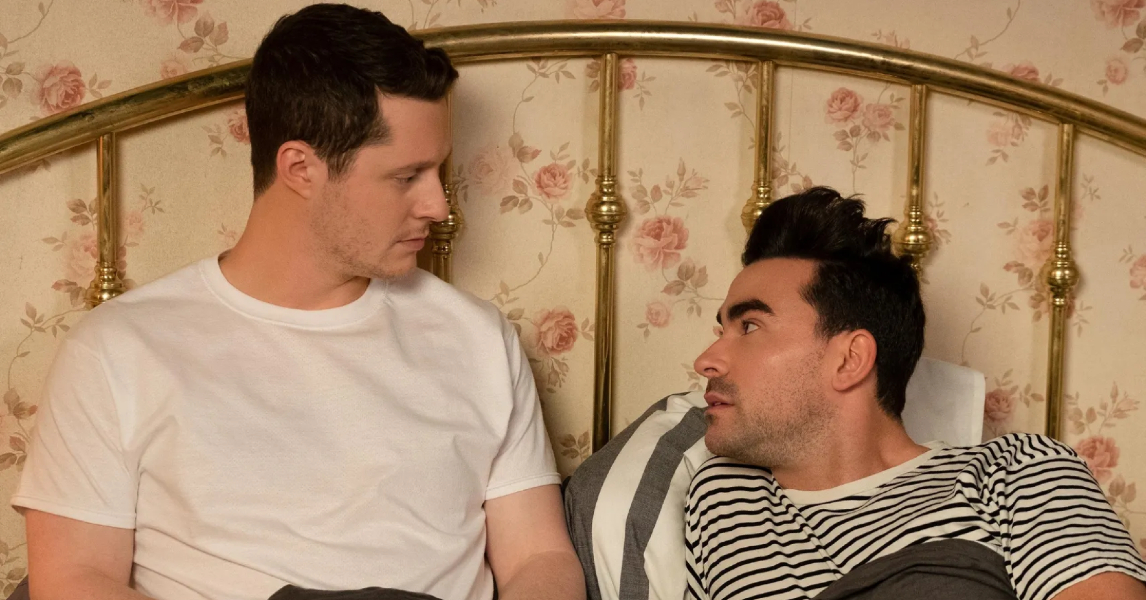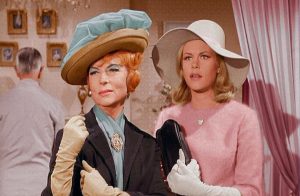Male bisexuality on television: From the ’90s to now
By: Josh Mckenzie

In the 1990s, I was constantly on the lookout for any mention of queerness in the TV guides that floated around my family home.
My ears and eyes were trained to pick up any hint that a show might include a character or storyline that could resonate with the chaotic feelings of desire, shame and fear that roiled away in my teenage body.
Image credit: Schitt’s Creek, CBC Television, 2020
The working class and conservative part of Western Sydney where I grew up was oppressively short on examples of non-normative sexualities. Short is an understatement; they were all but non-existent. Expression of homo-anything was considered a hazard to your health.
For this reason, I turned to the media that existed at the time to feel out the different ways characters expressed themselves. It’s as if those representations were a change room, where I could safely try on different identity forms to see what best reflected how I felt.
What I developed, despite not having the language or understanding to name it as such at the time, was what queer theorist José Esteban Muñoz described as a “tactical mode of recognition” in his book Disidentifications: Queers of Color and the Performance of Politics. This is the process of creatively locating aspects of yourself within a dominant culture that erases you from view, either through complete exclusion or stereotypically damaging representations.
The language of my sexuality, both private and shameful, was learned in fits and starts as I borrowed, stole and repurposed the few relatable examples I found around me, crossing the bridge of culture into my sense of identity.
My journey of self-discovery took a sharp turn towards clarity when the character Jack entered the Dawson’s Creek cast in 1998.
In a season two episode titled ‘Television of Yore’, Jack reads a homoerotic poem to his classmates that speaks of desire in a way that was both terrifying and relatable to me. The revelation of Jack’s same-sex desire is further complicated by his attraction to the female lead, Joey – a character I myself had a crush on. It seemed like maybe I had found an example of someone who felt the same way I did.
A couple of episodes later, Jack comes out as gay. I was suddenly confused.
Up until this point, I felt that we were on the same emotional page, so did that mean that I was gay like Jack? I’d had major crushes on girls at school, but no crushes on any of the boys, yet there was a sexual tension I felt with some male classmates.
What the hell did it all mean? In this instance, all this representation did was add to my confusion.
This confusion continued with other stereotypical representations that conveyed male bisexuality as gay in disguise. While Sex and the City comes to mind here, it was more than just the shows I watched. It was all the other cultural content that informed the views of those around me, constructing their opinions of male bisexuality with the same stereotypical and damaging views that would then get regurgitated back at me as fact.
One night, as I was flicking through the TV guide in the early 2000s, I came across a British show called Sinchronicity, and I thought to myself, “this might actually be what I’ve been looking for.” The blurb described a love triangle between two men and a woman. So of course, I made sure I was up late to watch it on SBS.
The protagonist Jason experiences turmoil resulting from his sexuality, which aligned with my own struggles at the time. While part of this depiction felt familiar, it was eventually inferred that Jason had always in fact been gay, despite his feelings for both the female and male love interests. It seemed to me that very little had changed on TV since 1998.
Strangely, the first show I saw that managed to depict male bisexuality without resorting to stereotype and dismissal was the fantasy series True Blood. During the second season, Eric, a thousand-year-old vampire, discusses his history of sex with people across various genders in a way that broke with the cultural tradition of feminising same-sex attraction. He was tough, and sometimes he liked to fuck men, so what?
This demonstrates the power of representation: a story filled with fictitious creatures can be shown to more accurately depict bisexuality over and above programs attempting to reach for realism.
In the intervening years, there were other representations that oscillated between the usual stereotypical and the almost-positive. But for me, major progress happened in 2015 with the airing of the incredible comedy Schitt’s Creek.
From the beginning, Schitt’s Creek set itself apart from all other representations of male bi/pansexuality with the character David. In a scene where David explains his attraction to people regardless of gender, he lands upon an iconic wine analogy:
“Um, I do drink red wine, but I also drink white wine. And I’ve been known to sample the occasional rosé […] I like the wine, not the label.”
David’s explanation conveys so much without even mentioning a single label or sexual orientation. But is innuendo and inference always the best route?
This question is addressed – however, much less elegantly – in the very millennial show Good Trouble. The male lead and love interest of the show’s two main female characters, Gael, is acknowledged as bisexual from the first episode. Despite being a little less nuanced, the way that Gael discusses his sexuality spoke to me like no other show had until this point.
Riding high from the path that has been paved before it, then came the amazing Heartstopper, the standout show of 2022 for me. But my experience of watching the series was a little different from most.
I loved Heartstopper, but only after eventually reaching the last episode. Too conditioned by all the other poor representation that came before it, damaged by the ‘really just gay’ narrative that I have been confronted with my whole life, I found Nick’s journey to be one of stress and fear. I assumed that in the end he would come out as gay, and he and Charlie would live their happily-ever-after gay lives.
When you are so used to seeing male bisexuality portrayed as an unnamed and nefarious feature of a character, or as being gay-in-disguise, it’s too easy not to see bisexuality as an actual real-life orientation. You begin to internalise these damaging stereotypes and come to think of yourself in a similar vein. I know I did.
I didn’t allow the space for Nick to exist as bisexual, because I had been burned too many times. Jaded, even.
Watching Heartstopper taught me so much.
It taught me that we have come a long way since my first encounters with multi-gender-attracted representation, it showed me change is possible, it encouraged me to view the world in a more reparative way, but mostly, it flooded me with a sense of validation that brought tears to my eyes.
Reflecting on these experiences, I was struck by the realisation that other people – ones who fit into the dominant model of the world – experience this kind of validation on a regular basis. And those who do not, because of their gender, race, sexuality, ethnicity, ability or social standing, often have to find glimpses of themselves in the subtextual cracks of hegemonic culture.
In a mass-mediated modern world, when we share diverse stories in realistic and compassionate ways, we open up the possibility for individuals to find themselves in the world around them. And we all deserve that experience.
Josh Mckenzie is a freelance writer living and working in Naarm (Melbourne). Along with writing for Goldrush Magazine, Archer and Eagle Leather, Josh recently completed a Master of Arts at La Trobe University studying Gender, Sexuality and Diversity and Creative writing. Josh is also adding the finishing touches to his first novel, Hart, which explores finding love in an inner-city gay sauna.













